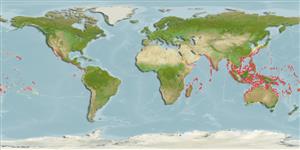Common names from other countries
Environment: milieu / climate zone / depth range / distribution range
Ecologie
; diepteverspreiding 62 - 64 m (Ref. 101029). Tropical
Indo-Pacific.
Length at first maturity / Size / Gewicht / Leeftijd
Maturity: Lm ? range ? - ? cm Max length : 10.0 cm ShH mannelijk/geslacht niet bekend; (Ref. 349); common length : 8.5 cm SHL mannelijk/geslacht niet bekend; (Ref. 349)
Length based on occurrence record; to be replaced with better reference. Lives in shallow waters near coral reefs (Ref. 799). Lower intertidal fringe and sublittoral to shelf zones (Ref. 349). Feeds on small crabs (Ref. 85382).
Life cycle and mating behavior
Geslachtsrijpheid | Voortplanting | Kuitschieten | Eieren | Fecundity | Larven
This species is a non-broadcast spawner. Life cycle does not include trocophore stage. Also Ref. 833.
Poutiers, J.M. 1998. (Ref. 349)
Status op de Rode Lijst van het IUCN (Ref. 130435)
Status bij CITES (Ref. 108899)
Not Evaluated
Not Evaluated
Gevaarlijk voor mensen
Harmless
Gebruik door de mens
Visserij: commercieel
| FishSource |
Tools
Meer informatie
Leeftijd/GrootteGroeiLengte-gewicht parametersLengte-lengte parametersMorfologieLarvenAbundantie
Internet-bronnen
Estimates based on models
Preferred temperature
(Ref.
115969): 20.6 - 28.5, mean 26.9 (based on 28 cells).
Kwetsbaarheid
Low vulnerability (10 of 100).
Prijsklasse
Unknown.
